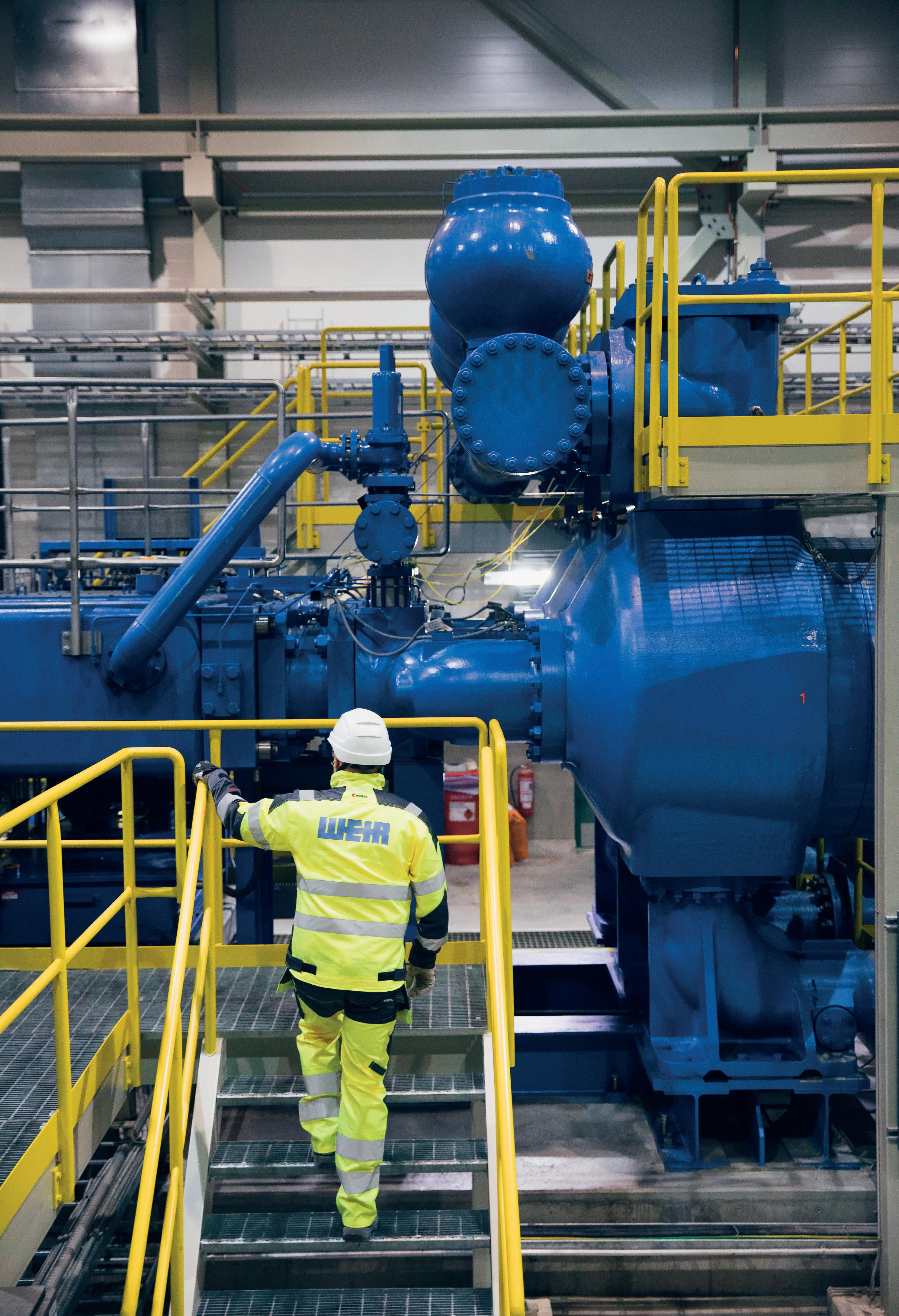
10 minute read
Pumping Sustainability
Erik Vlot and Job Kruyswijk, Weir Minerals, the Netherlands, identify how to make tailings management more sustainable.
At the launch of the Global Industry Standard on Tailings Management in August 2020, Ligia Noronha, Director of United Nations Environment Programme’s Economy Division, outlined how she hoped recent catastrophic tailings storage facility (TSF) failures would act as a catalyst for change in the mining industry: “The approach to mine tailings facilities must place safety first by making environmental and human safety a priority in management actions and on-the-ground operations.”
She acknowledged that change cannot happen overnight, and that existing infrastructure cannot simply be replaced; rather, it is a long-term undertaking and, as a first step, the industry needs to commit to improving many existing practices around tailings management.
“The Global Industry Standard on Tailings Management is an important milestone towards the ambition of zero harm to people and the environment from tailings facilities,” she added.
This focus on the environment – and awareness of the type of risks tailings pose to it – is a relatively new phenomenon. Historically, tailings were routinely discharged into the nearest water course. Today, tailings deposition is one of the mining industry’s most significant environmental challenges.
As Noronha alluded to, there is often crossover between implementing more sustainable tailings management solutions, reducing risk, and improving health and safety outcomes. This is because the major source of that risk is often the same – ‘wet’ tailings. Dewatering tailings to a paste, therefore, creates a more stable product that is safer and more sustainable to store.
In many projects, positive displacement pumps (PD) are the preferred pumps for transportation of paste tailings. These highly engineered pumps are the heart of the mine – their performance and reliability are integral to the overall operation. Thus, miners need pumps they can trust – proven pumps that consistently perform in the most demanding applications.

Paste tailings solutions
Figure 1. A GEHO® positive displacement pump from Weir Minerals at the Siilinjärvi mine in Finland.
Figure 2. Weir Minerals provided a fully integrated pumping solution to increase the life of mine and transform the tailings management process at Siilinjärvi mine in Finland. GEHO was founded in 1916, initially as casting manufacturers, but began manufacturing pumps during the Great Depression and Second World War. In 1974, GEHO built its first piston diaphragm pump for the transport of industrial slurry. An in-house test stand and a laboratory were constructed to conduct slurry trials, which enabled the company to further enhance its knowledge of how ore slurries behave when they are pumped through pipelines. The trials and tests were successful and led to an expansion of the GEHO® piston diaphragm pump range and new applications in ore transport, such as iron, copper, and gold ore. Despite the early success of the GEHO piston diaphragm pump, the business continued to develop new technologies and, by the 1980s, it was ready to launch a new range of PD, hydraulic driven piston pumps, for the transportation of slurry that contained large particles. In 1994, the company became part of the Weir Group PLC, further expanding its capabilities and cementing its reputation for innovative engineering. Weir Minerals has always been at the forefront of promoting paste tailings solutions, and the industry is now beginning to acknowledge and embrace the benefits of using pumps to transport paste. The TSF failures that prompted the development of the global standard were tragic and highlighted the urgency for the mining industry to focus its attention of the environmental risk posed by ‘wet’ tailings. The need to act – to replace legacy systems, equipment, and practices with more sustainable alternatives – becomes more pressing with each day. It is estimated that the world’s 29 000 – 35 000 active, inactive, and abandoned TSFs contain

approximately 534 billion m3 of tailings, with approximately 19 billion m3 of tailings currently added to that annually. With the growing demand for metals and minerals, as well as declining ore grades, this volume will only continue to rise. The shift to renewable energy also requires increased use of many metals, including: copper, lithium, cobalt, aluminum, iron, manganese, and silver. In many cases, the projected demand far exceeds the current production rates.
In 2020, a report estimated that over the next five years the industry will generate another 95 – 120 billion m3 of tailings.1 Needless to say, the risk posed to the environment is increasing and the need to develop sustainable solutions will be crucial to maintain a social license to operate.
Paste backfill
Paste tailings allow miners to manage their waste more sustainably, increase their water efficiency, and recover value from their waste.
Over the last decade, water has become more of an economic and environmental concern for mine operators. Paste tailings reduce a mine’s environmental footprint by utilising significantly less water compared with liquid tailings. For example, at 60% weight solids concentration, paste requires six times less water to pump than tailings with 20% weight solids concentration. Paste tailings can then be used as mine backfill to help ensure the structural stability of the mine; this extends the life of mine (LOM), keeping it profitable for longer so that all the ore can be mined.




Case study: Montana, USA
Sibanye-Stillwater Mine in Montana, USA, is a platinum group metals mine. It is a narrow vein operation and, therefore, it needs to backfill stopes once they have been mined. It utilises the mill tailings as mine backfill, which are transported by custom-fit GEHO pumps that pump the backfill at 70% solids. These pumps are critical to their operation from a production standpoint; reliability is paramount because if they cannot backfill a stope, they have to halt the entire operation. But it is also important from a sustainability point of view because it is putting rock back underground where it originally came from, reducing the mine’s environmental footprint.
The paste that is utilised as backfill obviously does not need to be stored on the surface. As not all tailings can be used for backfill, a large portion remains for surface disposal and there is an on-going debate within the industry around whether filtered or paste tailings provide the more sustainable tailings solution.
Customised, holistic solutions
It is important that miners approach tailings management holistically, rather than focusing on individual aspects of the process. There is often a tendency, for instance, to see filtered tailings as the more sustainable solution because it offers a higher rate of water recovery. However, this comes
INNOVATION Starts with IWT
Innovative is not just in our name. Our engineers thrive on solving tough mining problems, specializing in:
• Reliable Voice and Data Communications • Real-time Personnel & Asset Tracking • Wireless Gas Monitoring • Production & Environmental Sensor Data • Equipment State-of-Health Data • Production and Maintenance Analytics
at the expense of significantly higher fuel and power consumption and, therefore, increases carbon emissions. Filtered tailings, after all, need to be transported to the TSF, spread, and compacted.
Each site has its own geological and climatic conditions that need to be considered when developing tailings management solutions. In arid conditions, the tailings may remain unsaturated permanently; however, in wet or seasonally wet locations, the tailings risk being re-saturated over time. This may pose a threat to the long-term stability of the TSF.
Moreover, in arid conditions, while the total water recovery is 10% higher for filtered tailings compared to paste tailings, the efficiency improvement is offset by increased energy consumption for dewatering. Based on data recently published in a white paper presented by one of the authors of this article at the Paste 2021 Conference, energy consumption to dewater tailings is, on average, three times higher than for paste tailings. And when cake blowing is required, content energy consumption doubles again.
Sustainable tailings deposition cannot be approached in a one-size-fits-all manner; there are many factors to consider.
Improving energy efficiency with innovative engineering
The way sustainability is thought about and implemented has changed in recent years. It used to be approached in a very instrumental way, whereas now it often denotes a certain approach to mining. Conceived in much broader terms, its benefits are not simply environmental; in the same way that more sustainable tailings storage methods have the additional benefit of improving safety, implementing more energy efficient solutions often reduces operating costs.
There are opportunities to harness new technologies to improve the energy efficiency in brownfield operations, which often still operate legacy equipment. As plants needs to be upgraded, there are opportunities to explore new, innovative solutions that can help reduce a site’s carbon emissions.
Case study: Finland
Weir Minerals recently partnered with Yara to develop a solution to deal with the fact that its TSF at its Siilinjärvi phosphate mine in Finland was approaching its maximum holding capacity. An alternative TSF could not be created in the vicinity; instead, it was decided to place high density tailings on top of the existing stack.
Weir Minerals supplied a complete pumping solution to Yara, comprising three GEHO TZPM 2000 pumps and Warman® centrifugal pumps. It also supplied the required hydraulic actuated slurry valves, suction strainers, slurry instrumentation, and helped develop the functional description for Yara’s distributed control system (DCS).
GLORESTM system (Geho LOad REduction System) was also employed, which significantly improved pump capability and reduced operating costs. The GLORES system reduces the load to the power end, allowing the pump to generate higher power. This reduces the number of required pumps. In Yara’s case, the GEHO GLORES system reduced the number of required pumps from four (3 + 1 configuration) to three (2 + 1 configuration). It also improved the mean time between failure (MTBF) by reducing the amount of equipment installed and the number of components exposed to slurry.
The GEHO GLORES system works via double acting pumps, which displace fluid at both sides of the piston. The resulting rod load of such a configuration is the balance between the discharge pressure minus the suction pressure, both related to the loaded surfaces of the piston. The resulting rod force represents the actual load on the pump power end. Double acting pumps, generally in a two-cylinder configuration, have a lower overall power end load with systems operating at elevated suction pressure.
A standard configured single acting triplex pump only displaces fluid at the front of the piston and the power end will have to handle the full rod load generated during the pump discharge stroke. There is no gain while handling higher suction pressures. By applying a load at the backside of each piston, the resulting pump rod force and pump power end load is reduced during the piston discharge stroke.
The GEHO GLORES triplex pump is equipped with a dedicated hydraulic system, applying hydraulic pressure at the back of each of the three pistons, thus reducing the resulting rod load. The three connecting rods that drive the pistons are equally balanced at 120˚ of crankshaft angle. The total volume of the three interconnected chambers therefore remains constant during a pump crankshaft revolution. A small hydraulic system pressurises the piston chambers and maintains a system pressure that is related to the pump discharge pressure during normal operation. A small volume dampener will compensate for temperature and pressure related volume influences of the support system.
The system builds on existing technology; it is a simple, straightforward add-on that delivers operational capability, financial savings, and a more sustainable outcome.
Looking towards the future
The challenges surrounding tailings underpin a lot of the work being conducted at the Weir Technical Centre in Melbourne, Australia. One of the most exciting projects is the development of Terraflowing® system, which reduces water content of tailings waste by up to 82% in a cost-effective manner, enabling the tailings to be safely stored and opening up the opportunity for it to be used as a resource.
As mines produce more and more tailings, the issue of what do to with them becomes more urgent and increasingly intractable. The prospect of turning what has always been considered a waste product into a resource is just one example of how sustainable thinking is re-shaping the industry.
References
1. ‘State of World Mine Tailings Portfolio 2020’, worldminetailingsfailures.org, (2020).










